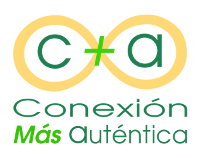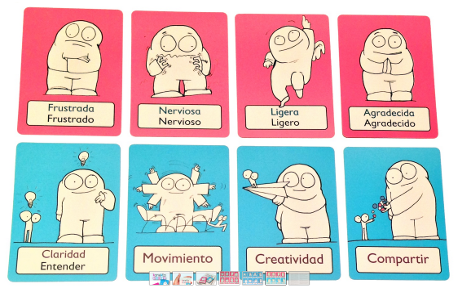Label: Education
Restorative Practices at school, a new way to resolve conflicts
5 May 2015.
Tags: CNV, Interpersonal communication, Education, In English, For parents, Texts CNV, Other Texts, Videos, Webs
Most disputes can be resolved in a satisfactory and beneficial way for all parties, provided that the necessary resources and time are dedicated. That's my personal and professional experience years learning, practicing and transmitting Nonviolent Communication. It's as basic (not easy) as the necessary conditions for that resolution occurs. For me there are several must-haves, which can be summarized as follows:
- An appropriate methodology, to allow all parties involved feel safe and respected in their rights.
- Professionals with experiential training in mediation and deep listening skills and “translation” messages to make them easier to listen to each person.
- A supportive community restorative processes, devoting time, spaces, human Resources, training…
- People willing to resolve conflicts in a way that ultimately all parties feel heard and that all parties leave satisfied with the solution.
So for me it is a joy to share the resources developed by a large community of people in the neighborhood are Gotleu in Palma de Mallorca (Mallorca), They are collecting and how they have worked each of those elements.
In this video you can see how they have been involved, with the revitalization of Institute for Coexistence and School Success (the Institute for Coexistence and School Success in Castilian) Government of the Balearic Islands, from the faculty of schools of Primary Education, Elementary and Secondary, students of all ages, the families, and Social Services, police, University and other significant social groups. A mosaic of voices, We make us an idea of the experiences of the creation of that network security in a socially vulnerable environment, and we see some results.
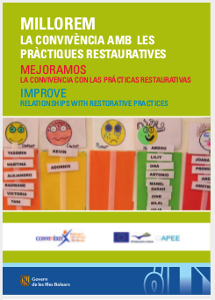 For a more systematic view, is the publication containing the fundamentals. Published in Catalan, Castilian and English as part of a European project this subject, the Guide to improve coexistence with Restorative Practices / Guide Mejoramos coexistence with the practices restorative develops the theoretical aspects of Restorative Practices, more accurate data and provides concrete examples and suggestions for further reading for more information.
For a more systematic view, is the publication containing the fundamentals. Published in Catalan, Castilian and English as part of a European project this subject, the Guide to improve coexistence with Restorative Practices / Guide Mejoramos coexistence with the practices restorative develops the theoretical aspects of Restorative Practices, more accurate data and provides concrete examples and suggestions for further reading for more information.
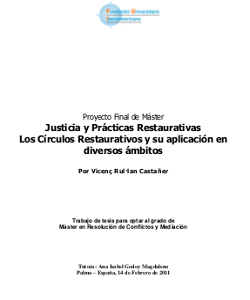 And to deepen the Restorative Circles, a practice of conflict resolution originated in the social dimension Nonviolent Communication, you can read the interesting monograph Justice and Restorative Practices. Restorative Circles and their application in various fields, written by Vicenç Rul·lan, a trainer who I have the pleasure of meeting, on the video and in the Guide, and he is a member of the Association of Restorative Justice Practices and Islands (to page Castilian and in Catalan, with several resources more). A good introduction, to further deepen this particular model. And you can also watch videos (English) on the official website of the creator of the Restorative Circles, Dominic Barter, RestorativeCircles.org.
And to deepen the Restorative Circles, a practice of conflict resolution originated in the social dimension Nonviolent Communication, you can read the interesting monograph Justice and Restorative Practices. Restorative Circles and their application in various fields, written by Vicenç Rul·lan, a trainer who I have the pleasure of meeting, on the video and in the Guide, and he is a member of the Association of Restorative Justice Practices and Islands (to page Castilian and in Catalan, with several resources more). A good introduction, to further deepen this particular model. And you can also watch videos (English) on the official website of the creator of the Restorative Circles, Dominic Barter, RestorativeCircles.org.
Who have done some training of interpersonal communication with me you have seen that ground mention this issue of Restorative Practices. I hope these resources illustrate a little better what you have heard me and I hope to awaken your creativity and your imagination to continue discovering more effective and deeper ways to resolve conflicts in the educational environment, and in any other area.
Xavier
Letters feelings and needs “EASY Konekta” de Simple Cat
6 February 2015.
Tags: CNV, Interpersonal communication, Education, For boys and girls, For parents
Nonviolent Communication It is a very profound tool, which should be developed by all means and through all possible channels. Those who have done workshops with me have seen the profusion of resources use (visual, space…), among other letters I-crafted, and I use over several years.
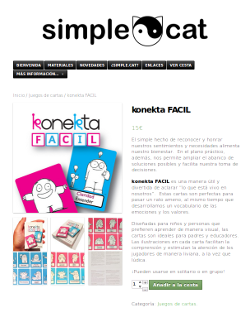 I was pleased a lot with the recent appearance of the letters “EASY Konekta”, a resource useful to accompany the processes of people who rely on the visual, especially children. In Simple Cat, a small company that is striving to bring and create teaching materials for training in Nonviolent Communication in Spain, They have chosen to launch these cards own design.
I was pleased a lot with the recent appearance of the letters “EASY Konekta”, a resource useful to accompany the processes of people who rely on the visual, especially children. In Simple Cat, a small company that is striving to bring and create teaching materials for training in Nonviolent Communication in Spain, They have chosen to launch these cards own design.
I just received letters “EASY Konekta” and I liked many aspects. On the one hand, the design, with simple drawings that make the cards very affordable, with pink background for the feelings and needs blue background (a code and universalized in the community of Nonviolent Communication by NVC Dance Floors).
On the other hand, the way they caring words: feelings are masculine and feminine, so that everyone can feel included us easily; and needs are often expressed in two complementary ways, so that the person can explore what is the word that fits you best.
Further, add a number of proposed use (Game suggestions), adapted from other sources with your permission, including the famous “Póker CNV”, that I use in deepening workshops.
From here my congratulations to the team Simple Cat this new resource. I'm looking forward to my next workshop try and see what they think those involved. Meanwhile you can explore more on the cards in the página web and you can buy them online if you're interested.
I trust that you are practical and easy to deepen Nonviolent Communication.
Xavier
NVC Dance Floors: practice Nonviolent Communication in a holistic manner
25 September 2014.
Tags: CNV, Interpersonal communication, Education, In English, My Classifieds, For Teens, For boys and girls, For parents, Psychotherapy, Therapy, Texts CNV, Videos
The NVC Dance Floors have already appeared in the version in Castilian, in which I have worked, and are also available videos subtitled in Spanish.
Bridget Belgrave and Gina Lawrie, Certified trainers for the Center for Nonviolent Communication (Center for NonViolent Communication, CNVC), years they created a great tool to teach and practice Nonviolent Communication (CNV). As they themselves have in submission, the NVC Dance Floors (NVC Dance Floors) They emerged through a series of steps to facilitate the practice of Nonviolent Communication with a spatial maps that allow use body size to work the emotional dimension, the way you see in this video:
In summer 2009 formarme had the pleasure to meet with Gina and Bridget, From there already work resumed translation and adaptation to the Castilian, an effort in which we have helped many people and I have coordinated for a while. So it is a pleasure to spread a simple tool and yet so deep, finally in Spanish, in which we care to include the largest possible number of Spanish version.
My experience is that the NVC Dance Floors the people can practice with just a few initial knowledge of Nonviolent Communication (In fact I sometimes use in introductory workshops). Even people who do not know the process of Nonviolent Communication itself (children, and adolescents, therapy clients) They can easily cross it with help from someone more experienced.
The NVC Dance Floors combine the visual, corporal and language, so that experience occurs through more channels and experience is deeper. And there are nine “dances” different, with names such as “The Dance of the 13 Steps”, “Integration and Dance Connection”, “The Dance of Anger / Rage, Shame and Depression”, “Dance of Yes and No”, The “Transform the pain of unmet needs in the Beauty Needs”.
Further, in 2013 they released some videos that explain three of these dances, in a neat edition that includes Spanish subtitles.
If you want to buy the dance floor CNV in different formats (as a download in PDF, on paper, plasticized version…) and DVDs to learn them at home or in group practice, you can visit its online store, Life Resources.
And if you want to count on me to try the dance floor in one session or in specific workshops, I will be happy to accompany.
I hope you like.
Xavier
Focusing Introductory Course “Listen to your body” (Nivel I) en Madrid, June 2014
21 June 2014.
Tags: Agenda filed, Education, Focusing, Focusing en Madrid, Training, For parents, Psychotherapy, Therapy
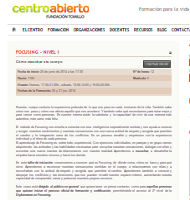 I have the honor of teaching together with my Focusing coordinator and friend Isabel Gascón Introductory Focusing Course “Listen to your body” (Nivel I). In this workshop we are going to work experientially on a friendly way of approaching our entire inner world from the bodily dimension.. Attitudes of respect and curiosity about what we find will mark a different way of being in the presence with our inner, and also a more open way of approaching what children experience, and adolescents. Aimed at both fathers and mothers as well as professionals in the help relationship, will experience through experiential exercises a more authentic connection with our intelligence bodily felt.
I have the honor of teaching together with my Focusing coordinator and friend Isabel Gascón Introductory Focusing Course “Listen to your body” (Nivel I). In this workshop we are going to work experientially on a friendly way of approaching our entire inner world from the bodily dimension.. Attitudes of respect and curiosity about what we find will mark a different way of being in the presence with our inner, and also a more open way of approaching what children experience, and adolescents. Aimed at both fathers and mothers as well as professionals in the help relationship, will experience through experiential exercises a more authentic connection with our intelligence bodily felt.
Date: viernes 20 de junio de 2014, of 17:30 a 21:30 and saturday 21 de junio de 2014 of 10:00 a 14:00 and of 16:00 a 20:00.
Place: Thyme Foundation Open Center
C/ Serrano No. 136
Madrid
More information and registration at the web page of the Open Center of the Tomillo Foundation.
This course is valid for obtaining the Diploma in Focusing from the Focusing Spanish Institute accounting as 12 hours Level I.
[Original entry 2 de junio de 2014, actualizada a 21 de junio de 2014, fecha de finalización del curso.]
Book “How to talk so your kids will listen and listen so your kids will talk” Adele Faber and Elaine Mazlish
20 May 2014.
Tags: Interpersonal communication, Education, For parents, Other Texts
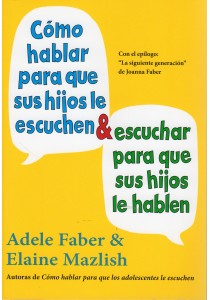 A few days ago I commented in a blog post by Spiral Consulting for Children, where I work on interpersonal communication issues for families and professionals who work with children, and adolescents, that sometimes a workshop to improve communication in the family or in the classroom serves to arouse interest, and aside from the insights gained and the tools learned, many people ask for more material to lean on. I like to recommend book Adele Faber y Elaine Mazlish (trainers and mothers) with the suggestive title How to talk so your kids will listen and listen so your kids will talk, a classic of communication with boys and girls that appeared in 1980. For years it has become a benchmark of positive parenting: empathetic and validating listening while setting limits and reaching satisfactory agreements for all parties involved.
A few days ago I commented in a blog post by Spiral Consulting for Children, where I work on interpersonal communication issues for families and professionals who work with children, and adolescents, that sometimes a workshop to improve communication in the family or in the classroom serves to arouse interest, and aside from the insights gained and the tools learned, many people ask for more material to lean on. I like to recommend book Adele Faber y Elaine Mazlish (trainers and mothers) with the suggestive title How to talk so your kids will listen and listen so your kids will talk, a classic of communication with boys and girls that appeared in 1980. For years it has become a benchmark of positive parenting: empathetic and validating listening while setting limits and reaching satisfactory agreements for all parties involved.
Inspired by the workshops that both authors carried out, The book is structured around the following contents: Chapter 1. How to help children deal with their feelings. Chapter 2. How to foster collaboration. Chapter 3. Alternatives to punishment. Chapter 4. How to stimulate autonomy. Chapter 5. the praise. Chapter 6. How to escape typecasting. Chapter 7. Recapitulemos. Further, in the latest edition of 2013 of Editorial Medici includes a look back from the authors to learning and experiences over more than thirty years and a touching afterword by Joanna Faber, with her experience as the daughter of the author Adele Faber and her encounter with her own motherhood.
From a positive view of the human being and human relations, the text is based on basic reasoning and many examples, some illustrated with vignettes that are like life itself, and continually offers ideas to be put into practice with the boys and girls around us. Although it is initially geared towards families, It can also be used in the educational and social field (although the authors have other specific books for the subject of studies).
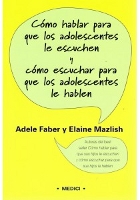 And if your sons and daughters (or the students you work with) they are older, you can also look at the book by the same authors How to talk so teens will listen and how to listen so teens will talk to you, offering some different ideas (appropriate for when they are older) and suggestions always useful, that will probably make you smile.
And if your sons and daughters (or the students you work with) they are older, you can also look at the book by the same authors How to talk so teens will listen and how to listen so teens will talk to you, offering some different ideas (appropriate for when they are older) and suggestions always useful, that will probably make you smile.
I wish you a happy reading, and that you enjoy exploring new forms of communication.
Xavier
Book “Focusing con niños” Marta Stapert y Erik Amorous
14 January 2014.
Tags: Education, CI Spirals, Focusing, For parents, Textos Focusing
As i count in a blog post from Spiral Consulting for Children, of which I am a member, between new year's resolutions, from Spiral Consulting Children we have proposed to publicize prevention and intervention tools in affectivity, protection and interpersonal communication that we are already using with children, girls and adolescents and what we recommend to families and professionals. Sometimes we recommend tools that have very little published in Spanish, or whose reference texts are difficult to obtain. Then we will give clues that we hope are indicative.
It is not the case of Focusing, the process and technique of body focus, which has abundant bibliography in Spanish. Focusing is a technique developed by Eugene Gendlin, experiential philosopher and humanistic psychotherapist, to consciously develop the ability to relate to our emotions in another way. Consists (explained in a few words) in using the references of the bodily sensations to work the emotions and the whole inner world (beliefs, internalized messages, recurring thoughts…). I am aware that explained like this it does not say much, and it is that Focusing is, basically, experiential, and that is why it can only be understood by experiencing it. Yes, once tested, most people recognize it as natural, something that “has happened to them at some point”, and with the Focusing technique we learn to use it when we want, and so it does not depend on our being with a special focus or capacity.
As with other techniques that I know, I approached Focusing on 2009 thinking about the applications it could have in the intervention with children, and yet I was captivated by the capabilities that it helped me discover in myself as a person and as a professional. If you are curious about this line of work, I have prepared two new formations, “Focusing and emotional education in children, and adolescents” and “Focusing and violence prevention in children, and adolescents” (both with recognition for official Focusing training, since I am recognized as Formador Certificado (Certified Trainer) by The Focusing Institute and for him Focusing Spanish Institute).
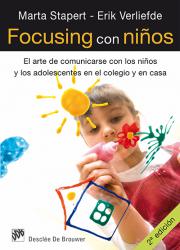 So to whet your appetite I recommend the magnificent book by Marta Stapert and Erik Verliefde Focusing con niños. The art of communicating with children and adolescents at school and at home, published by the Editorial Desclée in the Amae collection, supervised by the Spanish edition of Isabel Gascón and Lucía Ema, Focusing trainers and good friends of mine. Written by Marta Stapert, a child psychotherapist and Focusing coordinator, y Erik In love, a teacher, the book is a great introduction to Focusing for adults, while offering hands-on exercises and activities for people with children, girls and teenagers around, not only professionals from the therapeutic and educational fields, but also for families. Parents who have read it have found it very useful and practical, although there are some exercises that obviously improve a lot in a therapeutic setting.
So to whet your appetite I recommend the magnificent book by Marta Stapert and Erik Verliefde Focusing con niños. The art of communicating with children and adolescents at school and at home, published by the Editorial Desclée in the Amae collection, supervised by the Spanish edition of Isabel Gascón and Lucía Ema, Focusing trainers and good friends of mine. Written by Marta Stapert, a child psychotherapist and Focusing coordinator, y Erik In love, a teacher, the book is a great introduction to Focusing for adults, while offering hands-on exercises and activities for people with children, girls and teenagers around, not only professionals from the therapeutic and educational fields, but also for families. Parents who have read it have found it very useful and practical, although there are some exercises that obviously improve a lot in a therapeutic setting.
Hope you enjoy the (you can take a look at some of the content on the publisher's website).
Xavier
Video of Dan Pink on myths and realities of human motivation">Video of Dan Pink on myths and realities of human motivation
7 January 2014.
Tags: Education, CI Spirals, For parents, Videos
As I commented in this entry from the Spiral Consulting Children's blog, talking about education a few weeks ago I found myself mentioning again that rigorous scientific studies show that prizes and rewards work very short time and basically destroy intrinsic motivation in people, children, and adolescents included. Since the texts are usually operating primarily in English (if you insist I will make a post about them), I started researching to see what resources could be found in Castilian, and I was lucky to run into this magnificent video.
and Pink, after working writing for Al Gore, He became a writer and consultant on creativity. In her video she speaks of motivation in business, but if you substitute the word “company” by “school” every time, It will provide a fascinating insight into the educational reality (in our country and the world in general). To focus a little issue, the motivation (what drives us people to do things, whatever they are) can be “intrinsic” (when it is born of our own inner, as when we are curious, commitment, intentions contribution…) The “extrinsic” (when is a response to external conditions such “If you receive you beam A B”, whether B is a reward or a punishment).
I love that video, as he says, no one “feelings” to share even a “philosophy” to believe, but hard facts, contrasted by an entity so little suspicious “alternative” as the Federal Reserve Bank of Boston: “in eight out of nine tasks, the highest incentives (positive) They led to worse performance”. A) Yes. Why every time I hear that someone wants to reward or punish a child, or girl, I am worried. Will they use punishment or reward in that way that serves (one in nine), or they are undermining a little more intrinsic motivation of the person you want to educate? And I like the fact that the video continues with a proposal, brief but suggestive, how it works intrinsic motivation. Y, what a coincidence!, it turns out that this model of intrinsic motivation also works for human relations in general and schools in particular. I speak from experience, working for years with teenagers at social risk.
So nothing, Here's the video, and I love reading your comments.
Xavier
Módulos en curso de Educación Social de la Asociación Semilla en Madrid
4 October 2013.
Tags: Agenda filed, CNV, Education, CI Spirals, Training
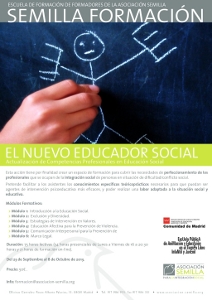 Como consultor de infancia en Spiral Consulting Children está previsto que imparta los módulos de “Educación Afectiva para la Prevención de Violencia” and “Comunicación Interpersonal para la Prevención de Violencia” (bases de la Comunicación No Violenta para profesionales de la Educación Social) dentro del curso “El nuevo educador social: Actualización de competencias profesionales en Educación Social” organizado por la Escuela de Formación de Formadores de la Asociación Semilla.
Como consultor de infancia en Spiral Consulting Children está previsto que imparta los módulos de “Educación Afectiva para la Prevención de Violencia” and “Comunicación Interpersonal para la Prevención de Violencia” (bases de la Comunicación No Violenta para profesionales de la Educación Social) dentro del curso “El nuevo educador social: Actualización de competencias profesionales en Educación Social” organizado por la Escuela de Formación de Formadores de la Asociación Semilla.
Dates (modules): Tuesday 1, Wednesday 2, Thursday 3 and Friday 4 October 2013, of 16:00 a 20:30.
Place: Asociación Semilla
Walk Alberto Palacios No. 13
28021 Madrid
More information and registration: 91 798 69 55
[Original entry 3 September 2013, actualizada a 4 October 2013, modules completion date.]
Book “Cuentos para descubrir inteligencias” de Begoña Ibarrola
4 September 2013.
Tags: Education, Narrative, For boys and girls, Other Texts
For its relevance to the development of an empathic attitude toward the capabilities we have everyone, regardless of our age and skills we have developed, copy content here entry I posted on Espirales Consulting Children, because it reflects a very hopeful vision of the human being.
Ever since I read about the theory of multiple intelligences, proposed and developed by psychologist Howard Gardner, He attracted me deeply. This American psychologist proposed in 1983 that intelligence was not unique (measuring the traditional tests are the logical-mathematical language and intelligences), it was multiple (the number has been increasing over the years and research), and also that each of the intelligences may develop. Since then he has combined research with the development of specific teaching materials for a more comprehensive education, and his work has been recognized by many institutions, including the Prince of Asturias Award for Social Sciences in 2011.
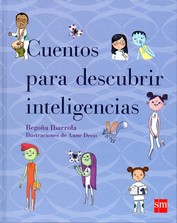 Begoña Ibarrola, a psychologist specializing in emotional development during childhood, us about a fun way to different intelligences in his book Cuentos para descubrir inteligencias, published by the grupo SM with endearing illustrations by Anne Decis. The story of a journey of a group of children terrestrial Pegasus, where they meet other children aliens, an excuse to explore the linguistic intelligences (ability with words and language), Mathematical logician (on numbers and logical operations), visuospatial (the ability to manage spatial and visual data, as in the graphic arts and engineering), musical (it has to do with music), bodily-kinesthetic (everything related to the body and movement), intrapersonal (on internal self-awareness capabilities), interpersonal (it has to do with social and group relations), naturalist (sensitivity to nature) and existential (the ability to reflect on the existence and other philosophical topics). Each component of the terrestrial group is paired with another Pegasus and together explore the intelligence that represent different stories of the book.
Begoña Ibarrola, a psychologist specializing in emotional development during childhood, us about a fun way to different intelligences in his book Cuentos para descubrir inteligencias, published by the grupo SM with endearing illustrations by Anne Decis. The story of a journey of a group of children terrestrial Pegasus, where they meet other children aliens, an excuse to explore the linguistic intelligences (ability with words and language), Mathematical logician (on numbers and logical operations), visuospatial (the ability to manage spatial and visual data, as in the graphic arts and engineering), musical (it has to do with music), bodily-kinesthetic (everything related to the body and movement), intrapersonal (on internal self-awareness capabilities), interpersonal (it has to do with social and group relations), naturalist (sensitivity to nature) and existential (the ability to reflect on the existence and other philosophical topics). Each component of the terrestrial group is paired with another Pegasus and together explore the intelligence that represent different stories of the book.
Oriented children Primary (although it can be used from four years), each story is introduced by a number of guidelines and suggestions for working families and professionals. I think a very valuable resource to explore with children their different capacities and to bring awareness to develop them, at the same time your self-knowledge and self-esteem is encouraged. On the other hand, It is a book that helps assess the evidence diversity everything that brings each of the intelligences (and they can prepare what they bring their friends from the capabilities of each).
Hope you enjoy it as much as the IM.
Alex Rovira Video on the Economics of caresses
30 May 2013.
Tags: CNV, Education, Focusing, Videos, Experiences
Alex Rovira, business advisor, lecturer and writer both as a novel test, has a positive view of the human being is very close to what we have from the Nonviolent Communication and Focusing.
In this short video gives some basic keys to working with people, both business management and for those who intervene more in the personal and social. The key phrase “Stroke economy” reflects one of the basic concepts that I try to convey in my work training and support: people seek to be seen, be recognized, and if they get through what we seek positive through most unpleasant reprimands. The key is to be aware of this and learn to read between the lines. To me this helps me in my work with adolescents and their families, and is the primary tool for building bridges between people.
The intention that it veáis video (repeatedly, even, to capture the subtleties) and introduce you to reflect on how the stroke economy in our private life, and also in the professional.
Hope you enjoy the.
Xavier
